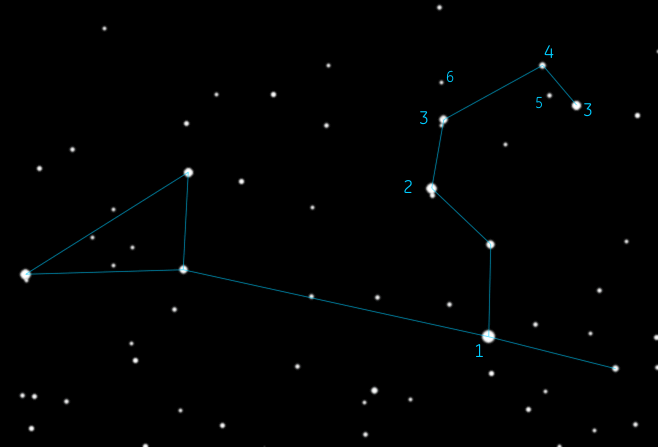
The Constellation Leo


|
The Constellation Leo |

|


As you look at this pair you might notice a tiny little ring around each star. This is a "diffraction ring" -- it's an interference pattern caused by light waves interacting with the edge of the telescope opening. Note: this is assuming I'm using my 90mm telescope at 90x magnification, a larger telescope or lower power will likely not show the diffraction rings. When you can see these rings, that's a sign that you have reached the limit of the detail your scope can show. You might be able to get to an even higher magnifying power, but you won't see any more detail. The image will only get fuzzier and darker.

Coma Berenices lies right in the middle of the Virgo cluster of galaxies, and in fact contains so much of the cluster that it is often referred to as the "Virgo-Coma Cluster". One of the best is the Black Eye Galaxy, just to the left of that little star right there {point out 35 Comae}. You can spot it with the binoculars, although we need a relatively large telescope (8" or better) to see the black eye at the center. It's actually a lane of dust that is the result of a collision with another galaxy -- literally smacking into this one and leaving it with a black eye.

Globular clusters are rare - only about 150 are known, and they are completely different from open clusters like M35 that we saw in Gemini.
M35 is estimated to be about 100 million years old, while M53 is estimated at about 10 BILLION years old, making it so old that it formed before the disk of the Milky Way galaxy formed! While M35 has several hundred stars in total, M53 has several hundred thousand stars. M35 is about 3000 light-years away and about 30 light-years across, M53 is 60,000 light-years away and 220 light-years across.
These numbers are typical, so globular clusters are much, much bigger than open clusters, and they are much, much older - some are nearly as old as the universe!

 Coma Berenices is the
only constellation in the sky whose legend is actually based on a true
historical incident. The story goes back to about 200 years BC,
in ancient Egypt. The king of Egypt at that time was Ptolemy, a shrewd king
who ruled well, advanced Egyptian influence in the world and along with his
father, established the library at Alexandria, an enormous achievement both
culturally and for the academic world.
Coma Berenices is the
only constellation in the sky whose legend is actually based on a true
historical incident. The story goes back to about 200 years BC,
in ancient Egypt. The king of Egypt at that time was Ptolemy, a shrewd king
who ruled well, advanced Egyptian influence in the world and along with his
father, established the library at Alexandria, an enormous achievement both
culturally and for the academic world.
But when the Assyrians murdered his sister, Ptolemy headed up an army on a mission of revenge. The Assyrians had a chilling reputation for ferocity, a reputation that has stayed with them right up to the present day. So Ptolemy's beautiful queen, that would be Berenice, made a promise to Aphrodite, the goddess of beauty, that if Ptolemy came back safe from his raid, she would cut off her long flowing hair and offer it to the gods.
The king did indeed return from the sortie in one piece, the queen did indeed cut off her hair and place it in the temple, and the hair was promptly stolen that very night. The king and queen were furious and the temple guards, having slipped up, were on the brink of being put to death when the court astronomer saved them through some quick thinking. Possibly already aware of the asterism behind Leo that resembles a tuft of hair, he announced that Aphrodite was so pleased with the gift that she had taken the offering and placed it among the stars. Incredibly, the king bought it, and the guards were spared.
So the moral is -- study your astronomy. You never know whose life you may save.
And on that note, our tour of the Spring night sky is completed. In early spring we may have spent some time early on picking up some of the more spectacular gems of the retreating winter titans. In late spring, we have Hercules and Lyra on the rise, with the spectacular globular cluster M13 and the best planetary nebula in the sky, the Ring Nebula, as described in the Summer Sky Tour, which the more robust stargazers might stick around to see. At this point, though, we've covered quite a bit of ground and it's usually just to about time to call it a night.
 Back to Bo÷tes
Back to Bo÷tes
|
 Go to Spring Index
Go to Spring Index
|
Your questions and comments regarding this page are welcome.
You can e-mail Randy Culp for inquiries,
suggestions, new ideas or just to chat.
Updated 25 April 2019